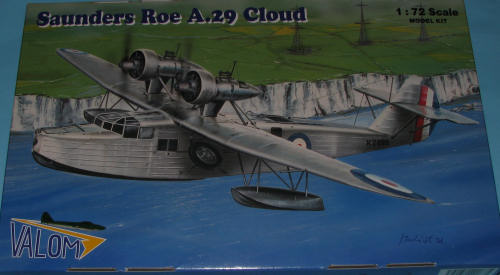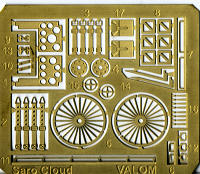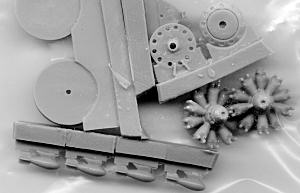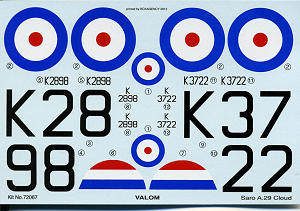
Valom 1/72 Saunders Roe A.29 Cloud
| KIT #: | 72067 |
| PRICE: | $ |
| DECALS: | Two options |
| REVIEWER: | Scott Van Aken |
| NOTES: | Short run kit with resin and photo etch parts |

| HISTORY |
The Saro Cloud was a British passenger amphibian flying boat designed and built by Saunders-Roe as the A.19 and later produced as the A.29 for the Royal Air Force for pilot and navigator training.
Following on from the success of the A.17 Cutty Sark the company designed an enlarged version designated the A.19 Cloud. It had room for a crew of two and eight passengers and like the Cutty Sark was a twin-engined monoplane flying boat with two engines strut-mounted above the wing. The design allowed for flexibility in engine fits and a four aircraft were sold to private operators with different engines fitted.
First flown in 1930 the prototype was fitted with two 300 hp (224kW) Wright J-6 radial engines. The Air Ministry ordered a prototype and 16 production aircraft for the Royal Air Force as pilot and navigator trainers. There was room for a crew of two and the former luxury cabin was replaced with chart tables for training six navigators at a time.
| THE KIT |
 Here
is another delightful subject from our friends at Valom. I have to admit this is
one of those subjects I thought would never be kitted, but am quite pleased that
it was. As you can tell from the historical section, this is the A.19/3.
Here
is another delightful subject from our friends at Valom. I have to admit this is
one of those subjects I thought would never be kitted, but am quite pleased that
it was. As you can tell from the historical section, this is the A.19/3.
Typical of Valom, the sprues have a number of parts that are not appropriate for the variant being kitted. The plastic itself is very nicely molded with a bit of excessive mold line on a few pieces, but otherwise typical for the upper end of the genre. Also typical is the need to drill a few holes and make some bits out of stretched sprue or wire.

 The cockpit
is the usual mix of plastic and etched brass with the latter material being used
for instrument panels and belts, for example. Acetate instrument sheets are also
provided to back up the brass panels. The cabin in this version is basically
just a seat and table. As this kit is the British military option, you will use
the supplied cowlings and the engine nacelles that are on more robust pylons.
This version uses just one set of props. The resin engines are a bit different
and you get four bombs with pylons to place under the wings if you so desire. I
had thought that the large radial etched bits were for the engine pushrods, but
these are for the outer portion of the wheels (the inner is solid).
The cockpit
is the usual mix of plastic and etched brass with the latter material being used
for instrument panels and belts, for example. Acetate instrument sheets are also
provided to back up the brass panels. The cabin in this version is basically
just a seat and table. As this kit is the British military option, you will use
the supplied cowlings and the engine nacelles that are on more robust pylons.
This version uses just one set of props. The resin engines are a bit different
and you get four bombs with pylons to place under the wings if you so desire. I
had thought that the large radial etched bits were for the engine pushrods, but
these are for the outer portion of the wheels (the inner is solid).
 The wheels have separate hubs and tires, which makes
painting easy. Looking at the instructions, the kit is designed for gear down,
but building it raised should not be an issue for those who may wish to try it.
This aircraft was a true amphibian so the gear was used on standard landing
fields. The wing floats are nicely done and should be sturdy. I found that the
use of resin fuselage halves was a neat way to handle the detail and rather
unexpected. A real benefit to many of us is that this one is quite light on
bracing with only a bit used on the tailplanes.
The wheels have separate hubs and tires, which makes
painting easy. Looking at the instructions, the kit is designed for gear down,
but building it raised should not be an issue for those who may wish to try it.
This aircraft was a true amphibian so the gear was used on standard landing
fields. The wing floats are nicely done and should be sturdy. I found that the
use of resin fuselage halves was a neat way to handle the detail and rather
unexpected. A real benefit to many of us is that this one is quite light on
bracing with only a bit used on the tailplanes.
Instructions are well done and have several superb drawings to help with parts placement. Both markings options are in aluminum lacquer with only the serial numbers being different between the two. The decal sheet is very nicely done and should pose no issues at all.
| CONCLUSIONS |
This is not your usual kit subject and should be a real delight to those who like to model 20's and 30's aircraft in general and airliners in particular. It is a kit that anyone with some experience in short run kits and the patience to build them should find to produce an excellent model.
| REFERENCES |
http://en.wikipedia.org/wiki/Saro_Cloud
March 2012
Thanks to Valom for the review kit. Ask for it where you get your hobby needs.
If you would like your product reviewed fairly and fairly quickly, please contact the editor or see other details in the Note to Contributors.